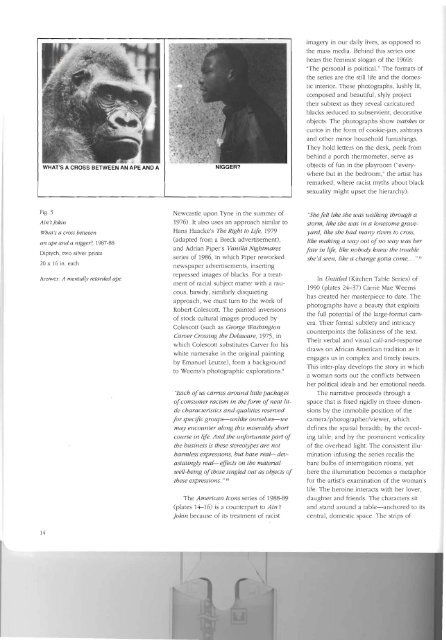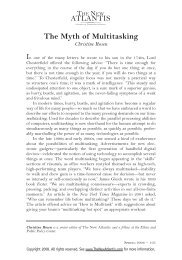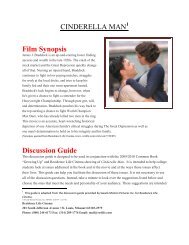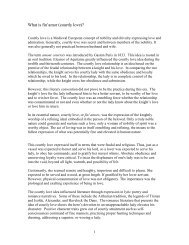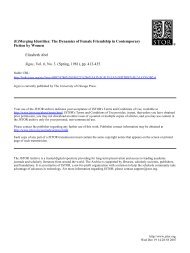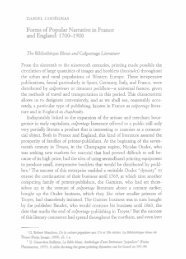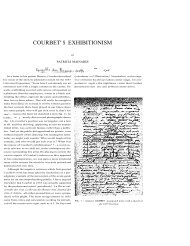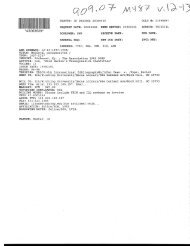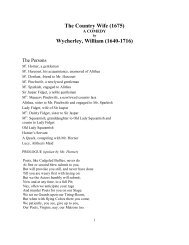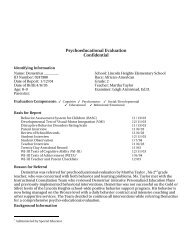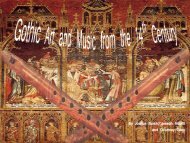CARRIE MAE WEEMS - People Search Directory
CARRIE MAE WEEMS - People Search Directory
CARRIE MAE WEEMS - People Search Directory
Create successful ePaper yourself
Turn your PDF publications into a flip-book with our unique Google optimized e-Paper software.
WHAT'S A CROSS BETWEEN AN APE AND A<br />
imagery in our daily lives, as opposed to<br />
the mass media, Behind this series one<br />
hears the feminist slogan of the 1960s:<br />
"The personal is political." The formats of<br />
the series are the still Jife and the domestic<br />
interior. These photographs, lushly lit,<br />
composed and beautiful, slyly project<br />
their subtext as they reveal caricatured<br />
blacks reduced to subservient, decorative<br />
objects. The photographs show tsatskes or<br />
curios in the form of cookie-jars, ashtrays<br />
and other minor household furnishings,<br />
They hold letters on the desk, peek from<br />
behind a porch thermometer, serve as<br />
objects of fun in the playroom ("everywhere<br />
but in the bedroom," the artist has<br />
remarked, where racist myths about black<br />
sexuality might upset the hierarchy).<br />
Fig. 5<br />
Ain't/akin<br />
What's a cross between<br />
an ape and a nigger?, 1987-88<br />
Diptych, two silver prints<br />
20 x 16 in. each<br />
Answer: A mentally retarded ape<br />
14<br />
Newcastle upon Tyne in the summer of<br />
1976). It also uses an approach similar to<br />
Ha ns Haacke's The Right to Life, 1979<br />
(adapted from a Breck advertisement),<br />
and Adrian Piper's Vanilla Nightmares<br />
series of 1986, in wh.ich Piper reworked<br />
newspaper advertisements, inserting<br />
repressed images of blacks. For a treatment<br />
of racial subject matter with a raucous,<br />
bawdy, similarly disquieting<br />
approach, we must turn to the work of<br />
Robert Colescott. The painted inversions<br />
of stock cultural images produced by<br />
Colescott (such as George Washington<br />
Carver Crossing the Delaware, 1975, in<br />
which Colescott substitutes Carver for his<br />
white namesake in the original painting<br />
by Emanuel Leutze), form a background<br />
to Weems's photographic explorations'"<br />
"Each of us carries around little packages<br />
ofconsumer racism in the form ofneat little<br />
characteristics and qualities reserved<br />
for specific groups-unlike ourselves-we<br />
may encounter along this miserably short<br />
course in life. And the unfortunate part of<br />
the business is these stereotypes are not<br />
harmless expressions, but have reat-devastatingly<br />
reat-effects on the material<br />
well-being ofthose singled out as objects of<br />
these expressions. " JO<br />
The American Icons series of 1988-89<br />
(plates 14-16) is a counterpart to Ain't<br />
Jokin because of its treatment of racist<br />
"She felt like she was walking through a<br />
storm, like she was in a lonesome graveyard,<br />
like she had many rivers to cross,<br />
like making a way out of no way was her<br />
fate in We, like nobody knew the trouble<br />
she'd seen, like a change gotta come, .. " II<br />
In Untitled (Kitchen Table Series) of<br />
1990 (plates 24-37) Carrie Mae Weems<br />
has created her masterpiece to elate. The<br />
photographs have a beauty that exploits<br />
the full potential of the large-format camera.<br />
Their formal subtlety and intricacy<br />
counterpoints the folksiness of the text.<br />
Their verbal and visual call-and-response<br />
draws on African American tradition as it<br />
engages us in complex and timely issues.<br />
This inter-play develops the story in which<br />
a woman sorts out the conflicts between<br />
her political ideals and her emotional needs.<br />
The narrative proceeds through a<br />
space that is fixed rigidly in three dimensions<br />
by the immobile position of the<br />
camera/photographer/viewer, which<br />
defines the spatial breadth; by the receding<br />
table; and by the prominent verticality<br />
of the overhead light. The consistent illumination<br />
infusing the series recalls the<br />
bare bulbs of interrogation rooms, yet<br />
here the illumination becomes a metaphor<br />
for the artist's examination of the woman's<br />
life, The heroine interacts with her lover,<br />
daughter and friends. The characters sit<br />
and stand around a table-anchored to its<br />
central, domestic space. The strips of


